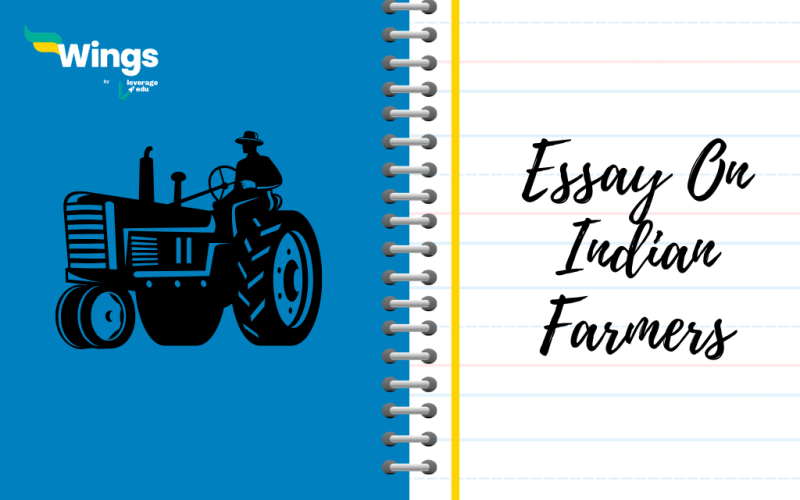Indian farmers are the backbone of the economy. They work tirelessly throughout the year to produce the best quality food. Since India’s soil fertility is rich, it allows farmers to grow two types of crops; Rabi and Kharif. To improve Indian farmers’ condition the Government of India has introduced schemes like PM Fasal Bima Yojana, Krishi Udan Scheme, National Mission on Natural Farming and many more. On this page, we will discuss some samples of essay on Indian farmers.
Table of Contents
Essay on Indian Farmers in 100 words
The farmers of India play a very important role in the economy of the country as agriculture is the primary source of livelihood for the majority of the Indian Population. They are hardworking, and resilient individuals who have a major impact on the development of the country. Although they play such an important role in the country, the farmers of India have to face numerous challenges which include lack of access to modern technology, lack of access to credit, and challenges related to irrigation and water management. Certain other aspects such as climate change, urbanization, etc are also affecting them. The government of India and society should take the necessary steps to address these challenges and hence support the Indian farmers to ensure a sustainable and prosperous future for the country.
Also Read:- Essay on Pollution
Essay on Indian Farmers in 200 words
The farmers of India play a very crucial role in the development of the country’s economy as well as the development of society. Even though they face several challenges such as lack of access to credit and markets, unpredictable weather conditions, etc they still work tirelessly to feed the nation. The hard work and dedication the Indian farmers show make the backbone of India’s agriculture which is the main source of livelihood of the majority of the population. They are a symbol of determination and their contributions to the country must be recognised.
The backbone bone of the Indian economy is agriculture and Indian farmers play a major role in the country’s economic growth. Agriculture employs around 50% of the country’s workforce and accounts for almost 17% of India’s GDP. Indian farmers don’t only practice agriculture, they grow livestock as well which is another important source of food and income for several families.
Agriculture is a major contributor to the country’s exports, with crops like rice, wheat, and cotton being some of the major export items. In addition, the Indian farmer also plays a critical role in the country’s food security. India is the world’s second-largest producer of food, and farmers in the country produce a wide range of crops, including rice, wheat, maize, sugarcane, and fruits and vegetables. We should acknowledge the role of our farmers in developing our nation and recognize the same.
Also Read:- Importance of Internet
Essay on Indian Farmers in 350 words
In India, agriculture accounts for almost 17% of the GDP and employs almost 50% of the population. The Indian farmers are the backbone of the Indian economy. They play a crucial role in the country’s development. Despite all this, they face numerous challenges.
Challenges Faced by the Indian Farmers
Farmers face several challenges despite their role in the Indian economy. One such major challenge is the lack of access to credit. A major portion of Indian farmers do not have the financial resources to invest in modern farming techniques. Hence, they are forced to take loans from money lenders who charge extraordinary interest rates making it difficult to repay the same.
One other major challenge is the lack of modern technology. The majority of farmers in India have to still rely on traditional and old farming methods. In addition to the same, they face challenges regarding water management and irrigation as well. In a lot of regions in the country, they are dependent on the monsoon for their crops, which can become quite unpredictable and hence, may lead to crop failures.
Zero Budget Natural Farming (ZBNF)
This is one of the methods that was developed to help farmers with low budgets and limited resources. This technique is based on the principle of using locally available resources such as cow dung and cow urine to improve soil fertility naturally. In this method, farmers rely on natural predators for pest control. This method was not only more sustainable, but it also helped increase crop yields and reduced costs for farmers.
Conclusion
Although change is happening in rural areas of India, they still have a long way to go. And although the situation of the farmers has improved, the growth is still not equitable. More efforts should be made by the Government of India towards the Indian farmers to provide them with modern technology and resources so that they thrive and have improved crop yields and hence that will eventually to the country’s economy and its development.
FAQs
A.1 The farmers of India play a very important role in the economy of the country as agriculture is the primary source of livelihood for the majority of the Indian Population. They are hardworking, and resilient individuals who have a major impact on the development of the country. Although they play such an important role in the country, the farmers of India have to face numerous challenges which include lack of access to modern technology, lack of access to credit, and challenges related to irrigation and water management. Certain other aspects such as climate change, urbanization, etc are also affecting them. The government of India and society should take the necessary steps to address these challenges and hence support the Indian farmers to ensure a sustainable and prosperous future for the country.
A.2 The Indian Government has launched several schemes for the welfare of Indian farmers: PM Fasal Bima Yojana, Krishi Udan Scheme, National Mission on Natural Farming, PM Kisan, Soil Health, etc.
A.3 Farmers work tirelessly to provide the nation with food to survive. They very extremely hard but still have to face several challenges such as lack of access to modern technology, poor soil quality, insufficient government support, etc. Such challenges have led to widespread distress and poverty among the farmers. However, now governments are taking initiatives to improve their situation, and hence the situation is improving. Crop yields are now better and have improved the livelihood of many farmers.
Popular Essay Topics
This brings us to the end of our blog on Essay on Indian Farmers. Hope you find this information useful. For more information on such informative topics for your school, visit our essay writing and follow Leverage Edu.
 One app for all your study abroad needs
One app for all your study abroad needs













